Marie-Antoinette has since become an icon and many actresses have portrayed her on the screen. Here is a selection of five of them.
Diana Karenne
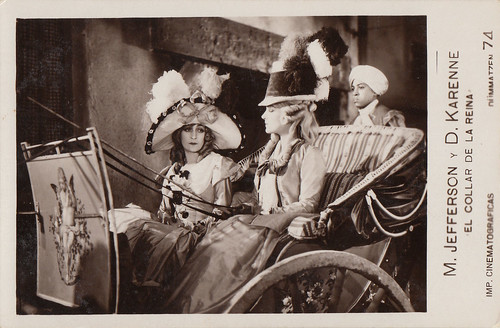
Spanish postcard by Dümmatzen, no. 74. Diana Karenne and Marcelle Jefferson-Cohn (a.k.a. Marcelle Chantal) in Le collier de la reine/The Queen's Necklace (Tony Lekain, Gaston Ravel, 1929).
Diana Karenne (1888-1940) was one of Italian silent movie history’s most famous divas. She played Marie-Antoinette twice: in the German-made Marie-Antoinette - Das Leben einer Königin (1922) and, at the end of her starring career, in the French production Le collier de la reine (1929).
Suzanne Bianchetti
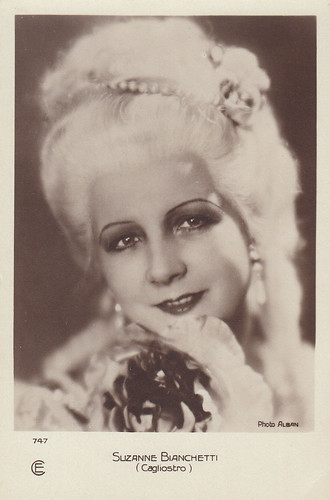
French postcard by Cinémagazine-Sélection, Paris, no. 747. Suzanne Bianchetti in Cagliostro/Cagliostro - Liebe und Leben eines großen Abenteurers (Richard Oswald, 1929). Photo: Alban.
French star Suzanne Bianchetti (1889-1936) was given several times aristocratic roles of empresses, queens, marchionesses or duchesses during her career. She played Marie-Antoinette twice: in Napoléon (1927) and Cagliostro (1929).
Norma Shearer
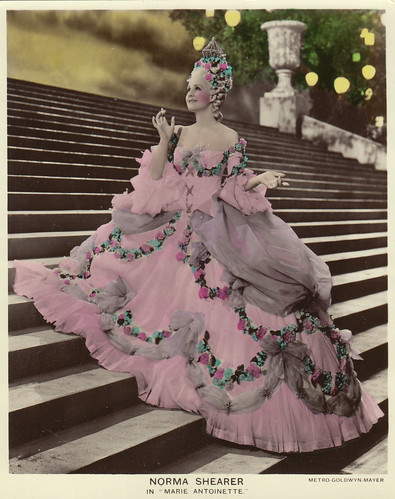
British large card by Picturegoer, in the Colored Art Series, no. CA 8. Photo: Metro-Goldwyn-Mayer. Norma Shearer in Marie-Antoinette (W.S. Van Dyke, 1938).

British postcard by Art Photo. Tyrone Power and Norma Shearer in Marie-Antoinette (W.S. Van Dyke, 1938). Photo: Metro-Goldwyn-Mayer.

British postcard in the Colourgraph Series, London, no. C302. Photo: Metro-Goldwyn-Mayer. Norma Shearer in Marie-Antoinette (W.S. Van Dyke, 1938).
In 1933, producer Irving Thalberg acquired film rights to Stefan Zweig’s best-selling book 'Marie-Antoinette: The Portrait of an Average Woman' and planned to film it as a lavish star vehicle for his wife, Norma Shearer. But it took several years of preproduction to see his project come to life.
After Thalberg’s death in 1936, Norma Shearer signed a new contract for six movies with M.G.M. in 1937 and it was announced that Marie Antoinette was scheduled to be the first of them. The budget was astronomical and no expenses were spared for the costumes, the wigs and the sets. Clothes designer Adrian, hair stylist Sydney Guilaroff and art director Cedric Gibbons surpassed themselves.
Norma Shearer was surrounded by a top-notch cast. Handsome Tyrone Power was borrowed from 20th Century Fox for the role of Count Axel de Fersen. John Barrymore was King Louis XV, Robert Morley was King Louis XVI, Anita Louise was Princesse de Lamballe, Gladys George was Madame du Barry and Joseph Schildkraut was the scheming Duke of Orleans.
It was an acting challenge for Norma Shearer, who was asked to run the gamut of emotions, from a naive young princess to a prematurely aged and broken lady. She was nominated for an Oscar for her performance and was awarded the Best Actress Volpi Cup at the Venice Film Festival.
At its release in 1938, Marie Antoinette was a massive hit. However, because of its enormous production costs, it lost money. But M.G.M. didn’t really care as they considered it was worth its deficit and that the company’s reputation was enhanced by such prestigious movies.
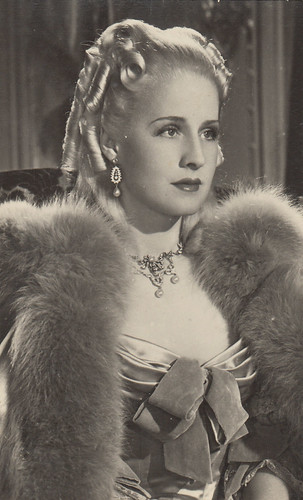
Spanish postcard by Archivo Bermejo, no. 4036. Photo: Metro-Goldwyn-Mayer. Norma Shearer in Marie-Antoinette (W.S. Van Dyke, 1938).

German postcard by Ross Verlag, no. A 1860/1, 1937-1938. Photo: Metro-Goldwyn-Mayer. Norma Shearer in Marie-Antoinette (W.S. Van Dyke, 1938).

German postcard by Ross Verlag, no. A 1944/1, 1937-1938. Photo: Metro-Goldwyn-Mayer. Norma Shearer in Marie-Antoinette (W.S. Van Dyke, 1938).
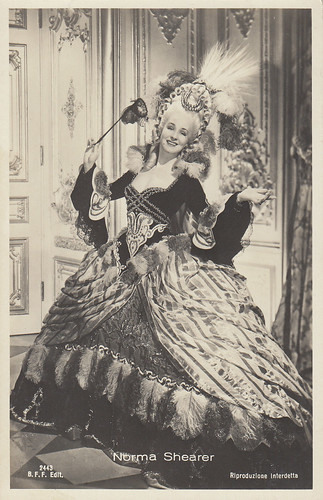
Italian postcard by Ballerini & Fratini, Firenze (B.F.F. Edit.), no. 2443. Photo: Metro-Goldwyn-Mayer. Norma Shearer in Marie-Antoinette (W.S. Van Dyke, 1938).
Lana Marconi

West-German postcard by Universum-Film A.G. (Ufa), Berlin Tempelhof, no. FK 955. Photo: C.L.M. Film, Paris / Pallas Film Verleih. Lana Marconi in Si Versailles m’était conté/Royal Affairs in Versailles (Sacha Guitry, 1954).
Romanian-born Lana Marconi (1917-1990) was the French author and director Sacha Guitry’s fifth and last wife. During her movie career, she appeared exclusively in films directed by her husband. She played Marie-Antoinette twice: in Si Versailles m’était conté (1954) and Si Paris nous était conté (1956).
Michèle Morgan
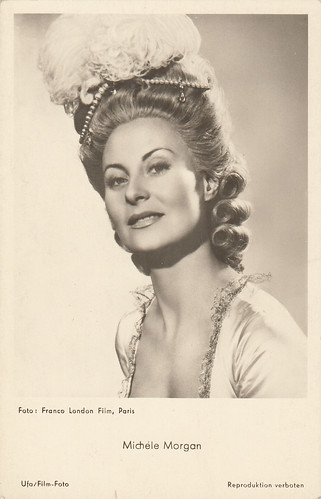
German postcard by Universum-Film Aktiengesellschaft (Ufa), Berlin Tempelhof, no. FK 3050. Photo: Franco London Film, Paris. Michèle Morgan in Marie-Antoinette reine de France/Marie Antoinette Queen of France (Jean Delannoy, 1956).
Marie-Antoinette reine de France (1956) was the sixth movie French star Michèle Morgan made under the direction of Jean Delannoy. Philippe Erlanger, who had been in 1939 one of the initiators of the Cannes film festival and who was working in 1956 at the Ministry of Foreign Affairs, co-wrote the script. He was quite an authority on historical subjects, as he published many biographies about the History of France. Several scenes were filmed at the Palace of Versailles, notably at the State’s Apartments, the Royal Chapel and the Petit Trianon. The movie was part of the official selection of the Cannes Film Festival in 1956.
Text and postcards: Marlene Pilaete.
No comments:
Post a Comment